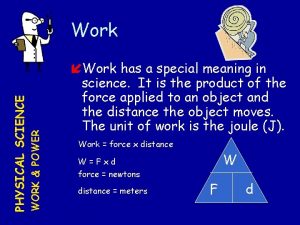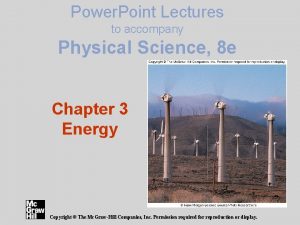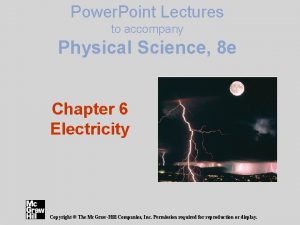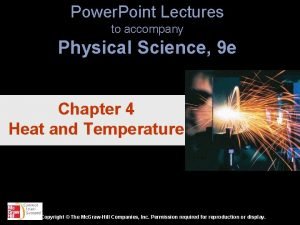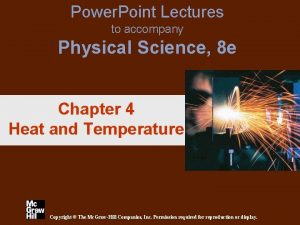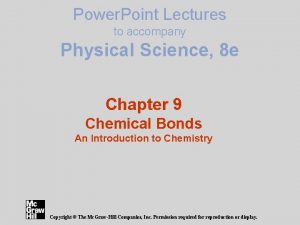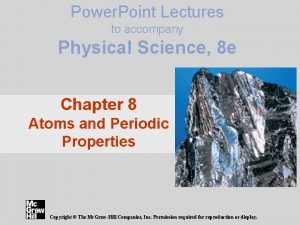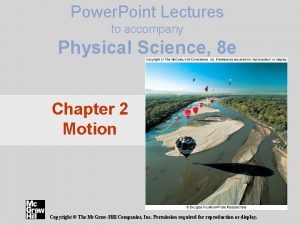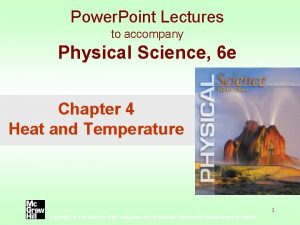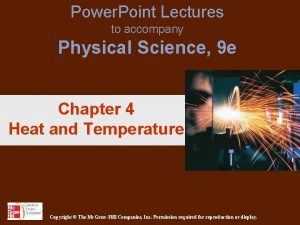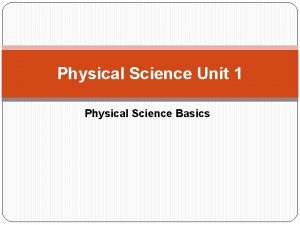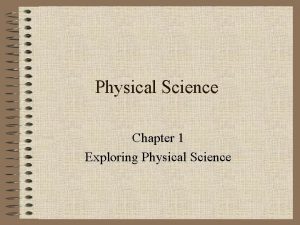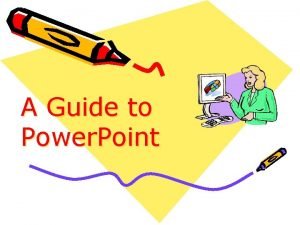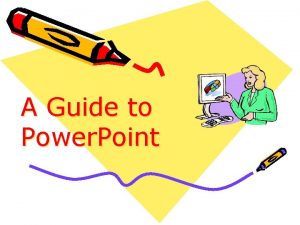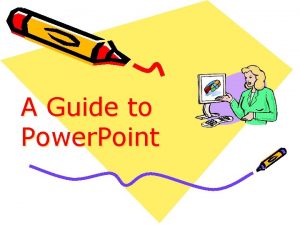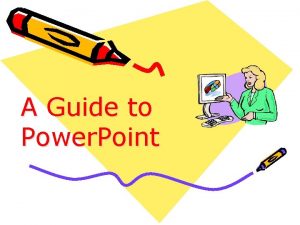Power Point Lectures to accompany Physical Science 8

























- Slides: 25

Power. Point Lectures to accompany Physical Science, 8 e Chapter 7 Light Copyright © The Mc. Graw-Hill Companies, Inc. Permission required for reproduction or display.

Core Concept Light is electromagnetic radiation– energy – that interacts with matter.

Structure • Regenerating cooscillation of electric and magnetic fields • Transverse waves • Electric, magnetic and velocity vectors mutually perpendicular • Electromagnetic spectrum

Sources of Light • Matter constantly emits and absorbs radiation • Emission mechanism – Accelerated, oscillating charges produce electromagnetic waves • Absorption mechanism – Oscillating electromagnetic waves accelerate charges within matter • Different accelerations lead to different frequencies • Luminous – Producing light – The Sun versus the nonluminous Moon • Incandescent – Glowing with visible light from high temperatures – Examples: flames, incandescent light bulbs

Blackbody Radiation Blackbody – Ideal absorber/emitter of light – Radiation originates from oscillation of near-surface charges Increasing temperature – Amount of radiation increases – Peak in emission spectrum moves to higher frequency Spectrum of the Sun

Properties of Light – Two Models Light ray model Wave model • Particle-like view • Photons travel in straight lines • Applications – Mirrors – Prisms – Lenses • Traces motions of wave fronts • Best explains – Interference – Diffraction – Polarization

Light Interacts with Matter • Interaction begins at surface and depends on – Smoothness of surface – Nature of the material – Angle of incidence • Possible interactions – Absorption and transmission – Reflection – Refraction

Diffuse Reflection • Most common visibility mechanism • Each point reflects light in all directions • Bundles of light from object are seen by the eye • Colors result from selective wavelength reflection/absorption

Reflection Details • Angles measured with respect to the “surface normal” – Line perpendicular to the surface • Law of reflection

Image Formation • Real image – Can be viewed or displayed at its location – Example - movie image on a screen • Virtual image – Appears to come from a location where it is not directly visible – Examples: plane mirror, convex mirror, concave mirror

Refraction • Light crossing a boundary surface and changing direction • Reason: change in light propagation speed – Moving to a medium with a slower propagation speed • Light bends toward surface normal – Moving to a medium with a faster propagation speed • Light bends away from the normal

Refraction, cont. • Mirages • Critical angle – Light refracted parallel to surface – No light passes through surface - “total internal reflection” – Applications - fiber optics, gemstone brilliance

Refraction, cont. • Index of refraction – A measure of light speed Substance Index of refraction Light speed Air Approx. 1 ~c Water 1. 333 0. 75 c Glass 1. 5 0. 67 c Diamond 2. 4 0. 42 c 18, 000 38 mph! BE condensate

Dispersion and Colors • • • White light – Mixture of colors in sunlight – Separated with a prism Dispersion – Index of refraction varies with wavelength – Different wavelengths refract at different angles – Violet refracted most (blue sky) – Red refracted least (red sunsets) – Example: rainbows Wavelength/frequency related

Optics • The use of lenses to form images • Concave lenses – Diverging lenses – Vision correction/in association with other lenses • Convex lenses – Converging lenses – Most commonly used lens – Magnifiers, cameras, eyeglasses, telescopes, …

The Human Eye • Uses convex lens with muscularly controlled curvature to change focal distance • Nearsightedness (myopia) - images form in front of retina • Farsightedness (hyperopia) - images form behind retina • Correction - lenses (glasses, contacts) used to move images onto retina

The Nature of Light Wave-like Behavior Diffraction • Bending of waves around objects • Shadows do not have sharp edges

The Nature of Light Wave-like Behavior Interference • Young’s two slit experiment • Interference pattern series of bright and dark zones • Explanation constructive and destructive interference

Wave-like Behavior Polarization • Alignment of electromagnetic fields • Unpolarized light mixture of randomly oriented fields • Polarized light electric fields oscillating on one direction

Wave-like Behavior Polarization • Unpolarized light mixture of randomly oriented fields • Polarized light - electric fields oscillating on one direction • Two filters - passage depends on alignment • Reflection polarization

Particle-like Behavior Quantization of energy • Energy comes in discrete quanta • Used by Planck to explain blackbody radiation observations • Particles of light = photons • Detected in digital cameras with CCDs (charge-coupled devices)

Photoelectric Effect • Ejection of electrons from metal surfaces by photon impact • Minimum photon energy (frequency) needed to overcome electron binding PE • Additional photon energy goes into KE of ejected electron • Intensity of light related to number of photons, not energy • Application: photocells

Special Relativity • Concerned with events as observed from different points of view • Based upon Einstein’s principles of – Consistent law principle – Constancy of speed principle

Special Relativity • Shows that measurements of length, time, and mass are different in different moving reference frames • The length of an object is shorter when moving. • Moving clocks run more slowly. • Moving objects have increased mass.

General Theory of Relativity • Also called Einstein’s geometric theory of gravity • Gravitational interaction is the result of the interaction between mass and the geometry of space • 4 th dimensional “spacetime” structure
 Hebrews 6:9-12 sermon
Hebrews 6:9-12 sermon Accompany chapter 1
Accompany chapter 1 Cephalic vein in hand
Cephalic vein in hand Printers create objects such as prototypes and models.
Printers create objects such as prototypes and models. Power system lectures
Power system lectures Wxhwebsite
Wxhwebsite Ac power formula
Ac power formula Natural physical science
Natural physical science Natural science vs physical science
Natural science vs physical science Power bi training powerpoint
Power bi training powerpoint English is my favourite subject noun
English is my favourite subject noun Point point power
Point point power Rick trebino
Rick trebino Neonatology lectures
Neonatology lectures Data mining lectures
Data mining lectures Advanced medicinal chemistry
Advanced medicinal chemistry Uva template powerpoint
Uva template powerpoint Cs614 short lectures
Cs614 short lectures Step wise project planning
Step wise project planning Molecular biology lectures
Molecular biology lectures Radio astronomy lectures
Radio astronomy lectures Dr sohail lectures
Dr sohail lectures Utilities and energy lecture
Utilities and energy lecture Introduction to web engineering
Introduction to web engineering Do words have power
Do words have power Frcr physics lectures
Frcr physics lectures





